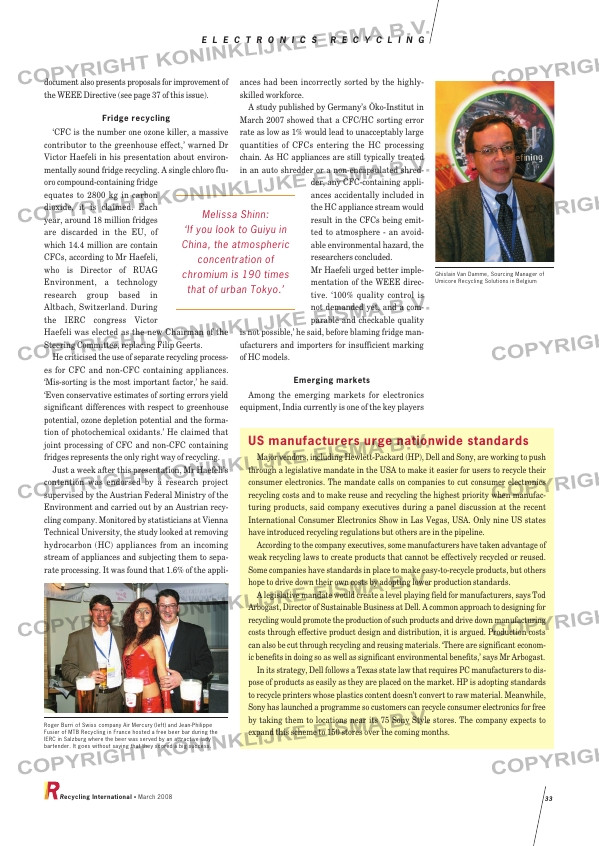Page 33 from: March 2008

document also presents proposals for improvement of
the WEEE Directive (see page 37 of this issue).
Fridge recycling
‘CFC is the number one ozone killer, a massive
contributor to the greenhouse effect,’ warned Dr
Victor Haefeli in his presentation about environ-
mentally sound fridge recycling. A single chloro flu-
oro compound-containing fridge
equates to 2800 kg in carbon
dioxide, it is claimed. Each
year, around 18 million fridges
are discarded in the EU, of
which 14.4 million are contain
CFCs, according to Mr Haefeli,
who is Director of RUAG
Environment, a technology
research group based in
Altbach, Switzerland. During
the IERC congress Victor
Haefeli was elected as the new Chairman of the
Steering Committee, replacing Filip Geerts.
He criticised the use of separate recycling process-
es for CFC and non-CFC containing appliances.
‘Mis-sorting is the most important factor,’ he said.
‘Even conservative estimates of sorting errors yield
significant differences with respect to greenhouse
potential, ozone depletion potential and the forma-
tion of photochemical oxidants.’ He claimed that
joint processing of CFC and non-CFC containing
fridges represents the only right way of recycling.
Just a week after this presentation, Mr Haefeli’s
contention was endorsed by a research project
supervised by the Austrian Federal Ministry of the
Environment and carried out by an Austrian recy-
cling company. Monitored by statisticians at Vienna
Technical University, the study looked at removing
hydrocarbon (HC) appliances from an incoming
stream of appliances and subjecting them to sepa-
rate processing. It was found that 1.6% of the appli-
ances had been incorrectly sorted by the highly-
skilled workforce.
A study published by Germany’s Öko-Institut in
March 2007 showed that a CFC/HC sorting error
rate as low as 1% would lead to unacceptably large
quantities of CFCs entering the HC processing
chain. As HC appliances are still typically treated
in an auto shredder or a non-encapsulated shred-
der, any CFC-containing appli-
ances accidentally included in
the HC appliance stream would
result in the CFCs being emit-
ted to atmosphere – an avoid-
able environmental hazard, the
researchers concluded.
Mr Haefeli urged better imple-
mentation of the WEEE direc-
tive. ‘100% quality control is
not demanded yet, and a com-
parable and checkable quality
is not possible,’ he said, before blaming fridge man-
ufacturers and importers for insufficient marking
of HC models.
Emerging markets
Among the emerging markets for electronics
equipment, India currently is one of the key players
Recycling International • March 2008 33
E L E C T R O N I C S R E C Y C L I N G
US manufacturers urge nationwide standards
Major vendors, including Hewlett-Packard (HP), Dell and Sony, are working to push
through a legislative mandate in the USA to make it easier for users to recycle their
consumer electronics. The mandate calls on companies to cut consumer electronics
recycling costs and to make reuse and recycling the highest priority when manufac-
turing products, said company executives during a panel discussion at the recent
International Consumer Electronics Show in Las Vegas, USA. Only nine US states
have introduced recycling regulations but others are in the pipeline.
According to the company executives, some manufacturers have taken advantage of
weak recycling laws to create products that cannot be effectively recycled or reused.
Some companies have standards in place to make easy-to-recycle products, but others
hope to drive down their own costs by adopting lower production standards.
A legislative mandate would create a level playing field for manufacturers, says Tod
Arbogast, Director of Sustainable Business at Dell. A common approach to designing for
recycling would promote the production of such products and drive down manufacturing
costs through effective product design and distribution, it is argued. Production costs
can also be cut through recycling and reusing materials. ‘There are significant econom-
ic benefits in doing so as well as significant environmental benefits,’ says Mr Arbogast.
In its strategy, Dell follows a Texas state law that requires PC manufacturers to dis-
pose of products as easily as they are placed on the market. HP is adopting standards
to recycle printers whose plastics content doesn’t convert to raw material. Meanwhile,
Sony has launched a programme so customers can recycle consumer electronics for free
by taking them to locations near its 75 Sony Style stores. The company expects to
expand this scheme to 150 stores over the coming months.
Roger Burri of Swiss company Air Mercury (left) and Jean-Philippe
Fusier of MTB Recycling in France hosted a free beer bar during the
IERC in Salzburg where the beer was served by an attractive lady
bartender. It goes without saying that they scored a big success.
Ghislain Van Damme, Sourcing Manager of
Umicore Recycling Solutions in Belgium
Melissa Shinn:
‘If you look to Guiyu in
China, the atmospheric
concentration of
chromium is 190 times
that of urban Tokyo.’
RI_008 Review IERC:Opmaak 1 28-02-2008 11:41 Pagina 33



